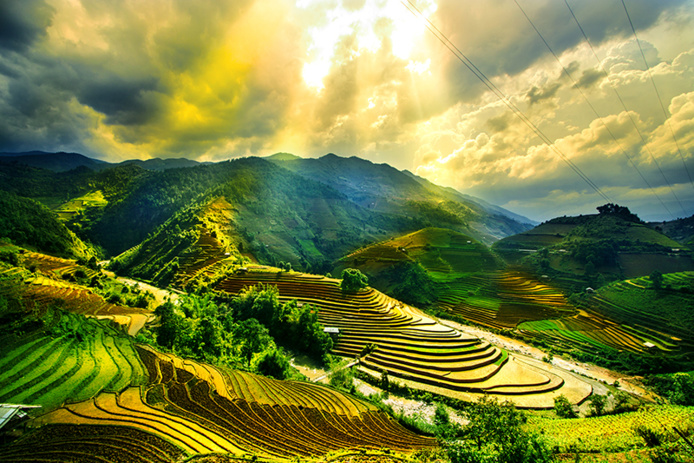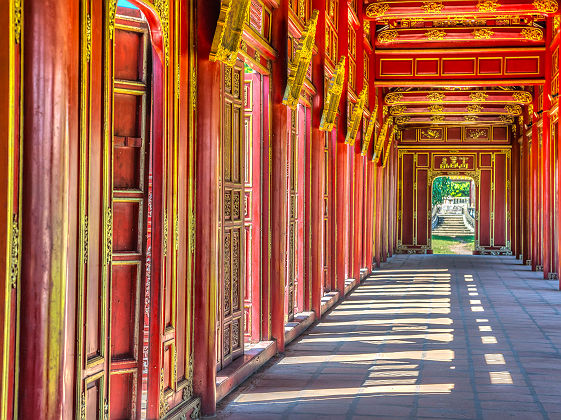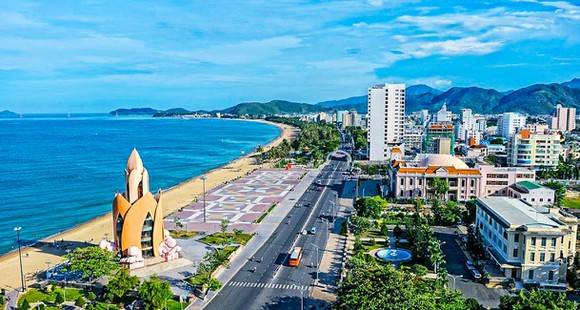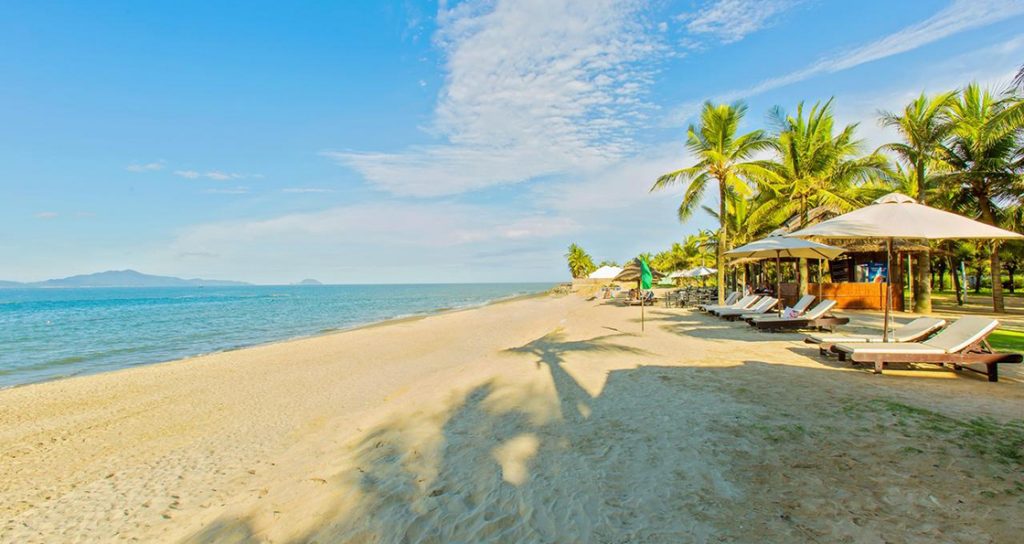WHEN TRAVEL TO VIETNAM ?
THE CLIMATE OF THE LAND OF THE BLUE DRAGON

This is THE question that we inevitably ask ourselves before taking our tickets: Is this the right time to travel to Vietnam? Between monsoon period and dry season, climate in the North of Vietnam and climate in the South of Vietnam, it is sometimes difficult to navigate!
The slender shape of Vietnam, which looks like a dragon, has differences in climate and temperature depending on the region, but rest assured, wherever you go, you are bound to find one with pleasant weather.
The ideal time to go to Vietnam is therefore a legend because it is a destination that can be visited all year round! But the best compromise is from March to May to visit the 3 regions.
Indeed Vietnam enjoys a very diverse climate because its territory extends over many latitudes and is varied in altitude. It is part of an intertropical zone and is characterized by strong sunshine but also a very high rate of precipitation.
Vietnam enjoys a hot and humid climate all year round which is tropical in the south and subtropical in the north marked by two seasons, the dry season and the wet or monsoon season.
Depending on whether you are in the north, center or south of the country, these two seasons are staggered in the year: the monsoon period extends from May to October in the north and south of the country while it goes from August to January in the center of the country.

⛅ North Vietnam Weather
The climate of Vietnam, to the north, enjoys what is known as the “Vietnamese winter”. This period, located between November and April, has cooler weather with temperatures between 20 and 30°C. However, the weather is usually gray and rainy in this area, making the weather a bit gloomy.
In Hanoi, the daytime temperature does not exceed 20°C in January. However, until March it can be cool with foggy weather. A short period of typhoons and violent showers occurs around September.
Summer, on the other hand, runs from May to September. It corresponds to the wet season with 15 rainy days or more in the month. The season is warmer and more humid with rains that can be very heavy and violent in July and August. Temperatures rise to over 33°C in May. The humidity in the air and the constant heat make the atmosphere quite moist and unpleasant. In the mountainous regions, the climate is more pleasant, with higher temperatures and less rain.
In the north of the country, it is cool and dry during the months of November to April.
To visit the north of the country, Halong Bay and the Hanoi region, the period from September to December is the most favorable (it is the time of the rice harvest which is called the « golden season » ) but from April to June, the period also has a certain charm.


The Haut-Tonkin region, located in the northern mountains, on the border with China, has a climate with well-marked seasons and high thermal amplitude due to the altitude.
✔ In summary :
- Spring (March to May) is the best time to travel with sunny and dry weather.
- The hot and humid summer is not very pleasant, the conditions for hiking being made difficult, and the low clouds can create a thick veil above the valleys.
- Autumn (September to November) is once again conducive to exploring Sapa and its surroundings despite still fairly high humidity and heavy showers that can occur in the late afternoon. However, beautiful sunny days generally allow you to enjoy the landscapes and the temperatures are milder..
- In winter, the cold sets in, with an alternation of beautiful days and gray skies.

⛅ Central Vietnam Weather
Central Vietnam has only three marked seasons. The region is just as humid as the rest of the country, but rainfall is even higher between November and late January. Indeed, the wet season is offset from the north.
This region is also subject to a summer monsoon which generally runs from May to November. It is during this period that the temperatures are the highest, especially between May and August, when the mercury often reaches more than 30°C in this part of Vietnam. The rainy season being out of step with the north and south of the country, it begins around August and ends in January. Better to expect gloomy or even rainy weather from November to January when the sun shines elsewhere.
On the Hauts Plateaux, you can still benefit from more pleasant temperatures than on the coast.
Attention, between September and October, it is also the season of the typhoons which can form at the time of the changes of monsoon.
Thus, the best time to visit this region is especially between February and May. It is the driest and sunniest season and the temperatures are mild.
✔ In summary :
- Spring (January to June) offers you sunny weather, a quite bearable temperature (between 25 and 35°C). Heat mists and showers announce dusk and sometimes continue into the night.
- Summer (July to September) is a mixed season, rather hot and humid.
- Autumn (September to January) is known as a busy season. The shores are swept and the land flooded by the tails of typhoons from the China Sea. The temperature is stable (15-20°C) but the weather very variable. Avoid if you want to relax on the beaches.
It is therefore better to favor the months of February to June during the dry season to travel through the center of the country, around Hue, Danang and Hoi An.


Finally, it is in this part of the country that we find the city considered the most pleasant in Vietnam in terms of weather. Indeed, Nha Trang enjoys a particularly pleasant microclimate with lots of sunshine and high temperatures. The climate is favorable from January to September.

⛅ South Vietnam weather
In the south of the country and in Ho Chi Minh City, only two seasons condition harvests and daily life and the temperature changes little over the year.
Southern Vietnam enjoys a dry and sunny period between November and April. The driest month is February. Also, with average temperatures between 30 and 36°C, the hottest months of the year are March and April. This heat wave heralds the wet season…
Indeed, the rainy season extends from May to September. It is characterized by an increase in precipitation which reaches its peak in July. The monsoon brings heat and heavy humidity with a risk of cyclones between August and October. Summer is therefore a time to avoid if you are planning a stay in southern Vietnam. The island of Phu Quoc for example becomes impassable due to heavy rains during this period.
Finally, it will also be necessary to be vigilant in relation to the floods of the Mekong which can be quite significant in August and September.
✔ In summary :
- The dry season (December to April) is the best time to visit the South. The temperatures are lower and the period is dry and sunny. From January to March then from October to December, the weather is mild, the sun is present but the heat is never excessive (20-30°C). This “beautiful season” has a welcome extension in the months of April and May.
- The rainy season (May to September) is not the best time because it rains almost every day. However, note that visits are still possible because the rain generally only falls at the end of the day and for a short time.
The sunnier dry season from December to April is therefore recommended for your visit.


🌤 Beach weather
On the sea side, the water temperature remains very high all year round on the entire coast, varying between 25°C and 28°C on the beaches of the China Sea and in the Gulf of Thailand, temperatures ideal for swimming.
Better to favor a stay in Phu Quoc, Phan Thiet or Mui Ne between October and April, then the central beaches during the summer months.


